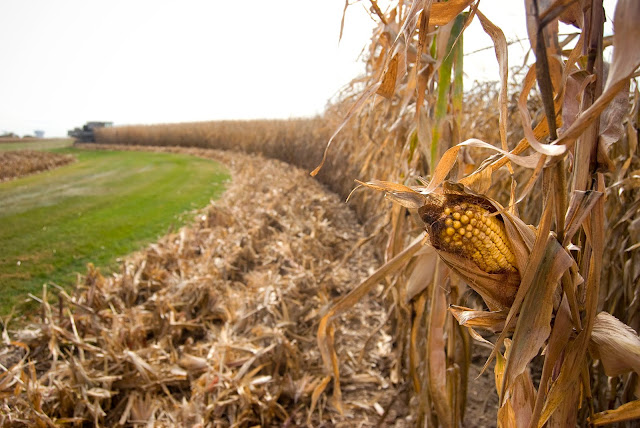Silking (R1) through dough (R4).
Depending upon your location in northwest Minnesota, your hybrid maturity and planting date, silking (R1), pollination and fertilization likely happened some time in early to mid-July. Right after fertilization kernel development begins, with the blister (R2), milk (R3) and dough (R4) stages following approximately 10 to 14 days, 21 days, and 24 to 28 days after pollination, respectively (Ritchie et al., 2005; Nleya et al., 2016; Hicks et al, 2018).
During the dough stage, one is no longer able to easily
squeeze kernels and see milky liquid come bursting out of the seed coat. This is
because this milky fluid is being replaced with starches to form a pasty,
dough-like consistency. While kernels are approximately 70% moisture during the
dough stage, as starches continue to accumulate more of the doughy consistency
is lost to firmer dry matter (Ritchie et al., 2005).
R5.
The R5 or dent growth stage is the last remaining stage for the crop to get through on its way to physiological maturity. This stage occurs approximately 5 to 6 weeks after silking and is named for the fact that after you peel back the husk leaves to reveal the kernels, the center of all (or most) of the kernels have a small indentation in the center (Nleva et al. 2016). This dent forms because the kernel tissue begins to dry down from the top of the kernel next to the silks, progressing toward the tip where the kernel attaches to the cob.
One can figure out how far along the crop is in this starch deposition process on its way to maturity by snapping an ear in half and looking at the kernels on the ear tip half of the broken cob for the milk line. The milk line is the dividing line between the white, dense starch layer (near the top of the kernel) and the more doughy material (toward the tip of the kernel) and it moves closer to the kernel tip as starch is deposited and the crops gets closer to maturity.
A corn crop that has reached the dent stage has advanced past when significant stress (such as a hail storm or foliar disease) would have led to fewer kernels. At R5, it is the weight of kernels (test weight) and not number that would be affected when encountering a significant stress (Ritchie et al., 2005). If a frost terminates the growing season before a black layer has formed between the kernel and the cob (signifying that the plant has reached physiological maturity) both test weight and the rate of dry down can be negatively impacted.
R6.
How far along is the crop?
The best way to figure this out is to pull some ears (not on the border rows), snap them in half and take a look to see whether the black layer has formed and, if not, where on the kernel the milk line is.
You can also take a look at the hybrid’s characteristics that are likely available on the seed company website to find information about the relative maturity of your hybrid (days to maturity) or the number of growing degree days needed to reach black layer. You can enter this information, your general location and planting date into the corn degree day decision support tool at the Midwest Regional Climate Center. This program takes into account historical weather trends and the daily high and low temperature for each day since you planted your crop this year to estimate when your crop is likely to reach maturity.
Using this program, an 80 day hybrid, planted near Crookston on May 15 is estimated to reach black layer between September 5 and 12 and both a 75 day hybrid planted on May 15 in the middle of Kittson County and an 85 day hybrid planted on May 15 in the middle of Clay County are both estimated to have already reached maturity.
References & Other Resources.
Hicks, D.R., Naeve, S.L. and Nicolai, D. 2018. (Corn) Growth and development. Online. UMN Extension. University of Minnesota. St. Paul, MN. {Accessed Sept 2, 2020}
MRCC. 2020. Corn growing degree day decision support tool. Online. Useful to Useable. Midwest Regional Climate Center. {Accessed Sept 2, 2020}
Nleya, T., C. Chungu, and J. Kleinjan. 2016. Chapter 5: Corn Growth and Development. Online. In Clay, D.E., C.G. Carlson, S.A. Clay, and E. Byamukama (eds). iGrow Corn: Best Management Practices. South Dakota State University. {Accessed Sept 2, 2020}
Ritchie, S.W., Hanway, J.J. and Benson, G.O. 2005. How a corn plant develops. Special report No. 48. Iowa State University Extension.
Comments
Post a Comment